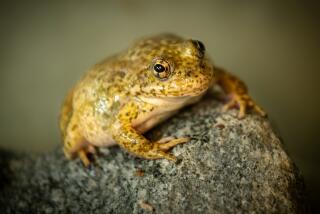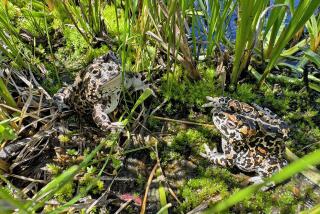Biologists Strive to Get a Jump on Prolific Frogs
SAN FRANCISCO — They may be unassuming, and sometimes even cute, but these slimy, 4-inch amphibians have some biologists worried about the future of Northern California’s lakes and streams.
The African clawed frog has spread throughout Southern California and now threatens the Sacramento-San Joaquin Delta with its alarming breeding rate and omnivorous appetite. Last summer an alarm bell went off when California Academy of Sciences researchers noticed that the frogs had taken up residence in Golden Gate Park’s Lily Pond.
The hearty, nonpoisonous amphibians can live in almost any condition -- including underground for up to two years. A female can lay hundreds of thousands of eggs every year. They will eat anything they can fit into their large, tongueless mouths, including other African clawed frogs.
Though Lily Pond is small, isolated and has just a few minnows and some turtles, biologists fear that the frogs could spread to coastal streams and the delta if they are not eradicated. That’s because the African clawed frog is small and cute -- the kind of animal a child might take home and set free later. Just a few could lead to the infestation of Northern California’s lakes and rivers, where species such as the endangered red-legged frog would suffer the consequences, biologists say.
The clawed frog, so named for its webbed, clawed back feet, probably found itself in Lily Pond about five years ago when a pet owner dumped a few without giving it much thought.
Hoping to keep people from picking up the creatures, the Department of Fish and Game launched an eradication effort last summer but canceled it at the last minute. Almost a year later, the department has no plans to jump-start the plan -- a decision some say is irresponsible.
The department’s original plan was to drain the pond and kill all the frogs. But the night before the operation was scheduled, Fish and Game headquarters called it off, citing a lack of funding and an unreliable strategy.
“The details weren’t in place.... We decided to slow down and take another look at it,” said Jim Swanson, supervising biologist at the department’s Central Coast regional office.
The man who was to oversee the operation said that wasn’t the case at all.
“I don’t buy that,” said Miles Young, a retired Fish and Game patrol lieutenant in charge of last year’s aborted operation. “I was the commander, we already had the people -- we had everybody in place. We were ready.”
As he stood at the edge of Lily Pond last week, Young pointed out thousands of tadpoles and hundreds of clawed frogs in the shallow water. The 27-year Fish and Game veteran said the original plan -- which included explosives, a screen to catch the eggs and tadpoles, and chemical treatment -- would have annihilated the frogs from the three-quarter-acre pond.
Swanson said the drained water could still contain tadpoles and eggs, thereby spreading the problem they were hoping to mitigate. Budget issues were another factor in the decision, he said.
Young blames the aborted effort on politics in the Sacramento headquarters, where he says top brass is still smarting from a botched eradication effort at Lake Davis in 1997. Fish and Game poisoned the lake to kill the nonnative northern pike, but the fish survived, while the drinking and fishing water was unusable for weeks.
Edward Erwin, a biologist with Merkel and Associates in San Diego who has studied African clawed frogs for about eight years, said he would have proceeded with even tougher eradication plans as quickly as possible.
“Once they start to spread in the larger system, you can never get rid of them,” Erwin said. “It’s better to spend more money up front
Authorities did neither in Southern California, Erwin said, where the critters now infest waters from Tijuana to Los Angeles. U.S. researchers first imported the frogs for pregnancy testing more than 50 years ago, Erwin said, but by the 1960s easier testing methods spawned the release of hundreds into the wild.
“They didn’t have a need for the frogs anymore. It was well intentioned but very misguided,” he said.
Cold North American weather killed most of the released frogs’ offspring, but, like so many nonnatives, the amphibians thrived in California’s forgiving environment. And once they started breeding, they were impossible to stop; their mating season, in which each female can lay numerous clutches of thousands of eggs, lasts almost half the year, Erwin said.
They also have an incredible ability to heal themselves -- a talent that may go unused on a continent that lacks any of the frogs’ natural predators.
In Southern California, eradication efforts have been “very unsuccessful,” Erwin said. “Once they become established, the population is secure. You could get rid of 99% of the frogs -- all they need is a handful to reproduce thousands of eggs.”
More to Read
Sign up for Essential California
The most important California stories and recommendations in your inbox every morning.
You may occasionally receive promotional content from the Los Angeles Times.










